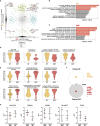Innate Lymphoid Cells Activation and Transcriptomic Changes in Response to Human Dengue Infection
- PMID: 34079535
- PMCID: PMC8165392
- DOI: 10.3389/fimmu.2021.599805
Innate Lymphoid Cells Activation and Transcriptomic Changes in Response to Human Dengue Infection
Abstract
Background: Dengue virus (DENV) infection has a global impact on public health. The clinical outcomes (of DENV) can vary from a flu-like illness called dengue fever (DF), to a more severe form, known as dengue hemorrhagic fever (DHF). The underlying innate immune mechanisms leading to protective or detrimental outcomes have not been fully elucidated. Helper innate lymphoid cells (hILCs), an innate lymphocyte recently discovered, functionally resemble T-helper cells and are important in inflammation and homeostasis. However, the role of hILCs in DENV infection had been unexplored.
Methods: We performed flow cytometry to investigate the frequency and phenotype of hILCs in peripheral blood mononuclear cells from DENV-infected patients of different disease severities (DF and DHF), and at different phases (febrile and convalescence) of infection. Intracellular cytokine staining of hILCs from DF and DHF were also evaluated by flow cytometry after ex vivo stimulation. Further, the hILCs were sorted and subjected to transcriptome analysis using RNA sequencing. Differential gene expression analysis was performed to compare the febrile and convalescent phase samples in DF and DHF. Selected differentially expressed genes were then validated by quantitative PCR.
Results: Phenotypic analysis showed marked activation of all three hILC subsets during the febrile phase as shown by higher CD69 expression when compared to paired convalescent samples, although the frequency of hILCs remained unchanged. Upon ex vivo stimulation, hILCs from febrile phase DHF produced significantly higher IFN-γ and IL-4 when compared to those of DF. Transcriptomic analysis showed unique hILCs gene expression in DF and DHF, suggesting that divergent functions of hILCs may be associated with different disease severities. Differential gene expression analysis indicated that hILCs function both in cytokine secretion and cytotoxicity during the febrile phase of DENV infection.
Conclusions: Helper ILCs are activated in the febrile phase of DENV infection and display unique transcriptomic changes as well as cytokine production that correlate with severity. Targeting hILCs during early innate response to DENV might help shape subsequent immune responses and potentially lessen the disease severity in the future.
Keywords: Dengue; ILCs; RNA-seq; immune response to dengue; innate immunity; innate lymphoid cells; transcriptome; viral infection.
Copyright © 2021 Poonpanichakul, Chan-In, Opasawatchai, Loison, Matangkasombut, Charoensawan, Matangkasombut and DENFREE Thailand.
Conflict of interest statement
The authors declare that the research was conducted in the absence of any commercial or financial relationships that could be construed as a potential conflict of interest.
Figures





Similar articles
-
Sequential waves of gene expression in patients with clinically defined dengue illnesses reveal subtle disease phases and predict disease severity.PLoS Negl Trop Dis. 2013 Jul 11;7(7):e2298. doi: 10.1371/journal.pntd.0002298. Print 2013. PLoS Negl Trop Dis. 2013. PMID: 23875036 Free PMC article.
-
Phenotype and functionality of follicular helper T cells in patients with acute dengue infection.J Biomed Sci. 2020 Apr 8;27(1):50. doi: 10.1186/s12929-020-00641-2. J Biomed Sci. 2020. PMID: 32264870 Free PMC article.
-
Molecular Signatures of Dengue Virus-Specific IL-10/IFN-γ Co-producing CD4 T Cells and Their Association with Dengue Disease.Cell Rep. 2019 Dec 24;29(13):4482-4495.e4. doi: 10.1016/j.celrep.2019.11.098. Cell Rep. 2019. PMID: 31875555 Free PMC article.
-
Innate immune responses to dengue virus.Arch Med Res. 2005 Sep-Oct;36(5):425-35. doi: 10.1016/j.arcmed.2005.04.007. Arch Med Res. 2005. PMID: 16099317 Review.
-
How Dengue Virus Circumvents Innate Immunity.Front Immunol. 2018 Dec 4;9:2860. doi: 10.3389/fimmu.2018.02860. eCollection 2018. Front Immunol. 2018. PMID: 30564245 Free PMC article. Review.
Cited by
-
Prediction of human protein interactome of dengue virus non-structural protein 5 (NS5) and its downstream immunological implications.3 Biotech. 2023 Jun;13(6):180. doi: 10.1007/s13205-023-03569-0. Epub 2023 May 12. 3 Biotech. 2023. PMID: 37193327 Free PMC article.
-
ILC1-derived IFN-γ regulates macrophage activation in colon cancer.Biol Direct. 2023 Sep 7;18(1):56. doi: 10.1186/s13062-023-00401-w. Biol Direct. 2023. PMID: 37679802 Free PMC article.
-
Longitudinal proteomic profiling of the inflammatory response in dengue patients.PLoS Negl Trop Dis. 2023 Jan 3;17(1):e0011041. doi: 10.1371/journal.pntd.0011041. eCollection 2023 Jan. PLoS Negl Trop Dis. 2023. PMID: 36595532 Free PMC article.
-
Dengue virus co-opts innate type 2 pathways to escape early control of viral replication.Commun Biol. 2022 Jul 22;5(1):735. doi: 10.1038/s42003-022-03682-5. Commun Biol. 2022. PMID: 35869167 Free PMC article.
-
RNA-Seq analysis of duck embryo fibroblast cells gene expression during duck Tembusu virus infection.Vet Res. 2022 May 18;53(1):34. doi: 10.1186/s13567-022-01051-y. Vet Res. 2022. PMID: 35585616 Free PMC article.
References
-
- World Health Organization . Dengue Haemorrhagic Fever: Diagnosis, Treatment, Prevention and Control. Geneva: World Health Organization; (1997).
-
- World Health Organization . GACVS Statement on Dengvaxia ® (Cyd-Tdv) (2017). Available at: https://www.who.int/vaccine_safety/committee/GACVS-StatementonDengvaxia-... (Accessed May 15, 2020).
Publication types
MeSH terms
Substances
LinkOut - more resources
Full Text Sources
Medical
Molecular Biology Databases
Miscellaneous

